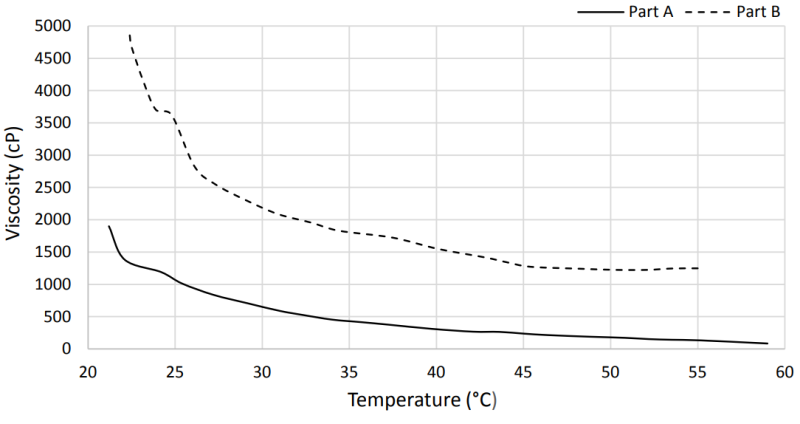Enhanced TDS
Knowde-enriched technical product data sheet
Identification & Functionality
- Chemical Family
- Product Type
- Technologies
- Product Families
Features & Benefits
- Labeling Claims
- Ready-to-Use Product Features
- Features & Benefits
- Color allows for visual inspection
- Low mixed viscosity of 2 700 cP
- Extremely high compressive and tensile strength
- Excellent adhesion to a wide variety of substrates, including metals, composites, glass, ceramics, and many plastics
- Excellent electrical insulating characteristics
- Extreme resistance to water and humidity
- Solvent-free
- Recommended Preparation
- Clean the substrate with Isopropyl Alcohol, MG #824, so the surface is free of oils, dust, and other residues.
Applications & Uses
- Markets
- Applications
- Compatible Substrates & Surfaces
- Mixing
- Scrape settled material free from the bottom and sides of the part A container; stir the contents until homogenous. Use a paint shaker if available.
- Measure 2 parts by volume of the part A and pour into the mixing container. Ensure all contents are transferred by scraping the container.
- Measure 1 part by volume of the part B and pour into the mixing container. Ensure all contents are transferred by scraping the container.
- Thoroughly and gently mix parts A and B together. Avoid introducing air bubbles.
- To de-air, let sit for 15 minutes or put in a vacuum chamber at 25 inHg for 2 minutes.
- If bubbles are present at the top, break them gently with the mixing paddle.
- Pour the mixture into a container holding the components to be protected.
- Close the part A and B containers tightly between uses to prevent skinning.
- Dispensing Accessories
Consult the table below for accessory selection. See the Dispensing Accessories Application Guide for usage instructions.
Cat. No. Dispensing Gun Static Mixer 832C-450ML 8DG-450-2-1 8MT-450
Properties
- Typical Properties
Value Units Test Method / Conditions Mix Ratio 2:1 Volume - Mix Ratio 2.3:1 Weight - Working Time 1 h - - Cured Properties
Value Units Test Method / Conditions Breakdown Voltage 60400 V - Compressive Strength 164 N/mm2 - CTE (After Tg) 161 ppm/˚C - CTE (Prior Tg) 150 ppm/˚C - Dielectric Constant (at 1 MHz) 2.8 - - Dielectric Strength 480 V/mil - Dissipation Factor (at 1 MHz) 0.02 - - Glass Transition Temperature (Tg) 53 °C - Hardness D 84 - - Intermittent Temperature 175 ˚C - Lap Shear (Aluminum) 18 N/mm2 - Lap Shear (Stainless Steel) 17 N/mm2 - Resistivity 6.7 x 10¹² Ω·cm - Service Temperature Range -40 to 140 ˚C - Tensile Strength 45 N/mm2 - Thermal Conductivity (at 25˚C) 0.3 W/(m·K) - - Uncured Properties
Value Units Test Method / Conditions Mixed Density 1.07 g/mL - Viscosity (at 25 ˚C) ⁽ᵃ⁾ 1.9 Pa·s - Viscosity (at 25 ˚C) ⁽ᵇ⁾ 6.6 Pa·s - - Cure Instructions
Allow to cure at room temperature for 24 hours, or cure in an oven at one of these time/temperature options:
Temperature 65 °C 80 °C 100 °C Time 1 h 30 h 15 min
Regulatory & Compliance
Technical Details & Test Data
- Viscosity vs. Temperature

If crystallization/solidification occurs, reconstitute the product by warming to between 55 and 65 °C until it becomes fully re-liquified. Let the material cool to room temperature before mixing, to prevent flash cure.
Mixing >500 g at a time decreases working life and can lead to a flash cure. Limit the size of hand-mixed batches. For large production volumes, contact MG Chemicals Technical Support for assistance.
- Cartridge
- Twist and remove the cap from the cartridge. Do not discard cap.
- Dispense a small amount to ensure even flow of both parts.
- (Optional) Attach a static mixer to the 832B-450ML. (a. Dispense and discard 5 to 10 mL of the product to ensure a homogeneous mixture.) (b. After use, dispose of static mixer.
- Without a static mixer, dispense material on a mixing surface or container, and thoroughly mix parts A and B together.
- To stop the flow, pull back on the plunger.
- Clean nozzle to prevent contamination and material buildup.
- Replace the cap on the syringe or cartridge.
Packaging & Availability
Storage & Handling
- Shelf Life
- 5 Years
- Storage and Handling
- Store between 16 and 27 ˚C in a dry area, away from sunlight (see SDS). Storage below 16 °C can result in crystallization.